The 13 Best State Parks in the United States to Visit in 2024: A Traveler’s Guide
- March 26, 2024
- 0 comment
Explore the 13 best state parks in the United States to Visit in 2024. This guide ranks the top 13 for unforgettable natural beauty and outdoor adventures. As we look ahead to 2024, the quest for adventure calls us to the vast, untamed wilderness of the United States. “The 13 Best State Parks in the United States to Visit in 2024: A Traveler’s Guide” is your passport to the most breathtaking landscapes the country has to offer. From the serene waters of hidden lakes to the majestic heights of ancient forests, our meticulously curated guide not only ranks the top state parks for their unrivaled natural beauty but also for the boundless outdoor adventures they provide.

Whether you’re a seasoned explorer or seeking a tranquil retreat into nature, prepare to be inspired by destinations where every visit leaves a lasting imprint, making 2024 a year of discovery and wonder in America’s greatest state parks.
List of 13 Best State Parks in the United States
- Custer State Park
- Valley of Fire State Park
- Antelope Island State Park
- Jedediah Smith Redwoods State Park
- Porcupine Mountains Wilderness State Park
- Dead Horse Point State Park
- Palmetto State Park
- Silver Falls State Park
- Watkins Glen State Park
- Fall Creek Falls State Park
- Baxter State Park
- Devil’s Lake State Park
- Oleta River State Park
Criteria for Selection
To identify the top state parks for 2024, we focused on:
- Diversity of Natural Features: Parks were chosen for their unique landscapes.
- Accessibility: We looked for parks that accommodate all levels of physical ability.
- Recreational Activities: Selection was based on the variety of available activities.
- Conservation Efforts: Parks leading in conservation practices were prioritized.
- Historical and Cultural Significance: Parks offering a connection to the past made the list.
- Visitor Experience: Positive reviews and well-managed facilities were key.
- Seasonal Beauty: Parks that offer distinct experiences across different seasons were included.
Why State Parks?
State parks offer unique opportunities to engage with the natural world in ways that larger national parks sometimes cannot. They are often less crowded, providing a more intimate experience with nature. Additionally, visiting state parks supports local economies and conservation efforts, ensuring these precious landscapes remain protected for future generations.
The 13 Best State Parks in the United States to Visit in 2024
1. Custer State Park, South Dakota
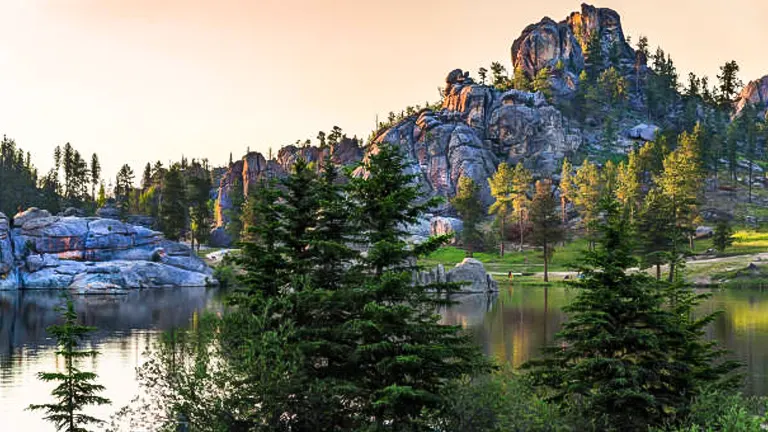
Nestled in the scenic Black Hills, Custer State Park spans over 71,000 acres and offers a blend of majestic landscapes, rich history, and abundant wildlife. This park, established in 1912, serves as a sanctuary for one of the largest bison herds in the United States, making wildlife viewing a highlight of any visit.
- Location: Black Hills, South Dakota
- Best Time to Visit: May to October, when the park’s full splendor is accessible and weather conditions are most favorable.
- Key Attraction: The annual Buffalo Roundup, held in late September, where visitors can witness cowboys and cowgirls herding over 1,300 bison, is an unforgettable sight.
- Ecosystem: The park’s diverse habitats, from rolling prairies to rugged mountains, support a variety of species including elk, pronghorn antelope, and the elusive mountain lion.
Additional Features:
- Scenic Drives: The Needles Highway and Iron Mountain Road offer some of the most picturesque drives in the region.
- Outdoor Activities: Hiking, fishing, horseback riding, and camping are just a few of the ways visitors can immerse themselves in the natural beauty of Custer State Park.
2. Valley of Fire State Park, Nevada
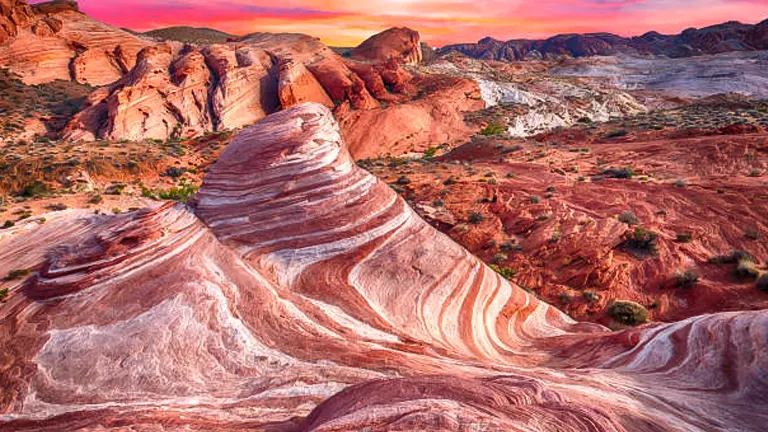
The oldest and largest state park in Nevada, Valley of Fire is a marvel of the Mojave Desert, known for its vibrant red sandstone formations that illuminate the valley, especially at sunrise and sunset. The park’s history is as rich as its landscapes, with petroglyphs dating back over 2,000 years, offering a glimpse into the lives of the ancient Ancestral Puebloans.
- Location: Overton, Nevada
- Best Time to Visit: October to April, to avoid the extreme temperatures of the desert summer.
- Key Attraction: The Fire Wave, a stunning sandstone formation with swirling patterns of red, pink, and white, rivals the beauty of the more famous Wave in Arizona.
- Ecosystem: The desert environment hosts a range of hardy flora and fauna, including the bighorn sheep, desert tortoise, and a variety of cactus species.
Additional Features:
- Hiking Trails: Over 20 miles of trails, from easy walks to challenging hikes, offer visitors diverse perspectives of the park’s geological wonders.
- Camping Opportunities: Two campgrounds provide the chance to experience the desert under a canopy of stars.
3. Antelope Island State Park, Utah
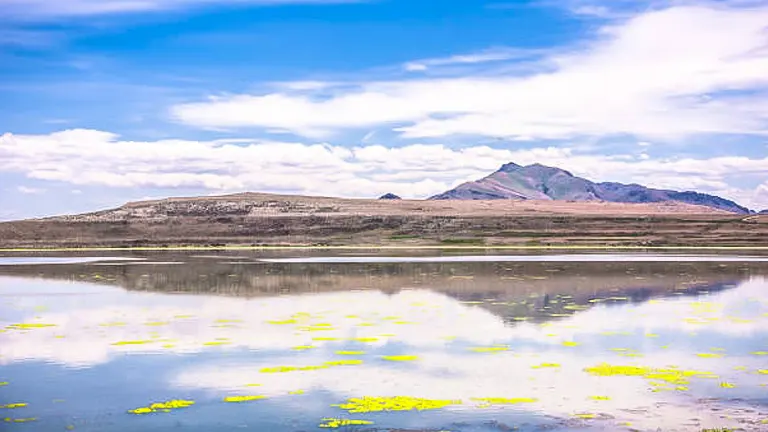
Floating in the saline waters of the Great Salt Lake, Antelope Island is not only a unique geographical feature but also a haven for a multitude of wildlife. The largest of the Great Salt Lake’s islands, Antelope Island is renowned for its serene landscapes, offering a stark contrast to the urban sprawl of nearby Salt Lake City.
- Location: Great Salt Lake, Utah
- Best Time to Visit: Spring and fall are ideal for comfortable temperatures, bird migration viewings, and wildflower blooms.
- Key Attraction: The island’s diverse wildlife, particularly its namesake antelope and one of the largest free-roaming bison herds in America, offers unparalleled wildlife photography and viewing opportunities.
- Ecosystem: The unique saline ecosystem of the Great Salt Lake supports a variety of bird species, making it a crucial stopover for millions of migratory birds.
Additional Features:
- Recreational Activities: Hiking, mountain biking, and horseback riding on over 40 miles of trails provide visitors with endless exploration opportunities.
- Educational Programs: Ranger-led tours and educational programs offer insights into the island’s natural history and conservation efforts.
4. Jedediah Smith Redwoods State Park, California
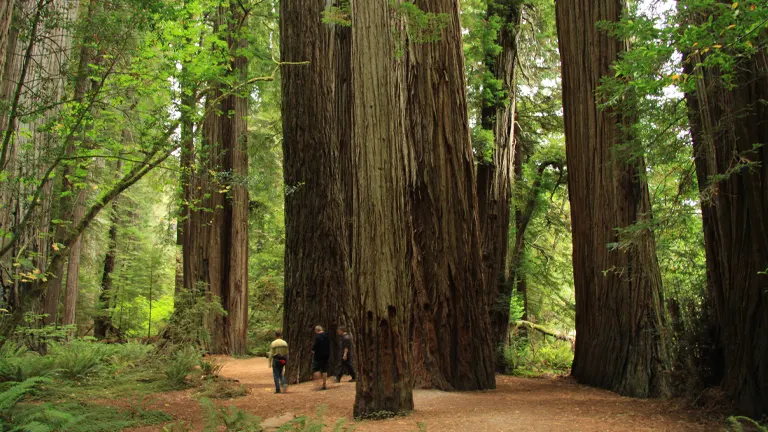
Immersed in the primeval beauty of the northern California coast, Jedediah Smith Redwoods State Park is a sanctuary of some of the world’s tallest trees. This park is a living museum, home to redwoods that have stood for millennia, offering a glimpse into the earth’s ancient past.
- Location: Near Crescent City, Northern California
- Best Time to Visit: May to October, for dry weather perfect for hiking and camping.
- Key Attraction: Stout Grove, where sunlight filters through the towering canopy, illuminating the forest floor in a soft, ethereal light.
- Ecosystem: The park’s dense redwood forests provide habitat for species such as the northern spotted owl, black bears, and a rich understory of ferns and shrubs.
Additional Features:
- Hiking and Camping: Over 20 miles of trails and multiple campgrounds allow for deep exploration and overnight stays amidst ancient giants.
- River Activities: The Smith River, one of the cleanest in the USA, offers opportunities for fishing, kayaking, and swimming.
5. Porcupine Mountains Wilderness State Park, Michigan

Known as “The Porkies,” this rugged landscape in Michigan’s Upper Peninsula is a testament to nature’s grandeur. With nearly 60,000 acres of untouched wilderness, the park is a haven for adventurers seeking solitude and natural beauty.
- Location: Ontonagon and Gogebic Counties, Michigan
- Best Time to Visit: Late spring to early fall for hiking, and winter for snow sports.
- Key Attraction: The Lake of the Clouds, offering one of the most iconic views in Michigan, with its vast, mirror-like waters set against a backdrop of dense forests.
- Ecosystem: The park’s vast forests, rivers, and lakes support wildlife such as moose, gray wolves, and the bald eagle.
Additional Features:
- Backcountry Camping: For those looking to immerse themselves in wilderness, the park offers backcountry camping permits.
- Hiking Trails: Over 90 miles of trails wind through ancient forests, along rivers, and to scenic overlooks.
6. Dead Horse Point State Park, Utah
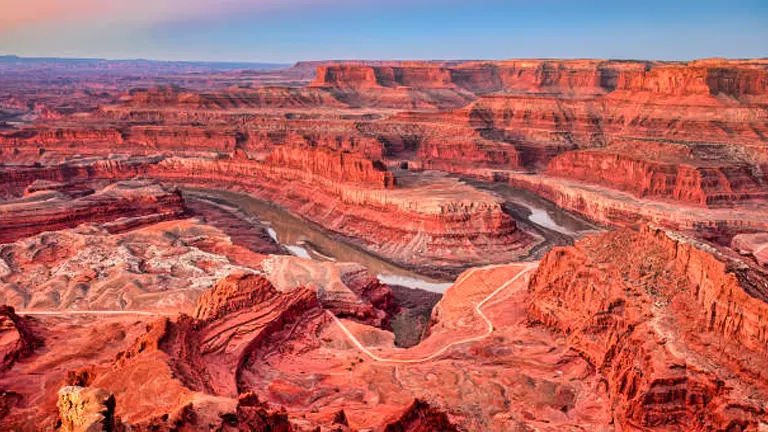
Perched 2,000 feet above the Colorado River, Dead Horse Point State Park offers breathtaking panoramas of Utah’s canyon country. Its dramatic overlooks provide views that rival the Grand Canyon, with layers of geological history stretching out to the horizon.
- Location: Near Moab, Utah
- Best Time to Visit: Spring and fall, when temperatures are mild and the views are unobstructed.
- Key Attraction: The park’s signature vista from Dead Horse Point, offering a dramatic overlook of the Colorado River and Canyonlands National Park.
- Ecosystem: The desert landscape is home to unique flora and fauna adapted to survive in harsh conditions, including juniper trees, cacti, and desert bighorn sheep.
Additional Features:
- Star Gazing: Recognized as an International Dark Sky Park, it’s an ideal spot for stargazing and night photography.
- Hiking and Biking: A network of trails offers visitors the chance to explore the park’s scenic beauty on foot or by bike.
7. Palmetto State Park, Texas
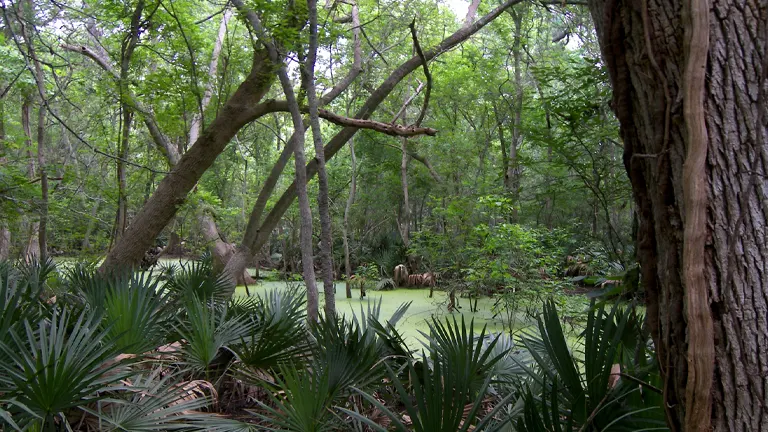
A lush oasis in the heart of Texas’ dry landscape, Palmetto State Park is a rare find. With its tropical feel, the park is named after the dwarf palmettos that blanket the ground, creating a landscape unlike any other in the state.
- Location: Gonzales County, Texas
- Best Time to Visit: Spring for wildflowers and cooler temperatures, and fall for bird watching and mild weather.
- Key Attraction: The San Marcos River runs through the park, offering clear waters for canoeing and fishing.
- Ecosystem: The park’s unique “swampy” areas provide a habitat for a wide array of wildlife, including armadillos, raccoons, and over 200 bird species.
Additional Features:
- Hiking and Birdwatching: A network of trails offers peaceful walks through the palmettos and along the riverbank, perfect for birdwatching enthusiasts.
- Camping and Picnicking: With ample camping sites and picnic areas, visitors can enjoy a full weekend immersed in nature.
8. Silver Falls State Park, Oregon

Oregon’s largest state park, Silver Falls State Park, is often referred to as the “crown jewel” of the state park system. Famous for its spectacular waterfalls, the park offers a stunning display of Oregon’s lush landscape.
- Location: Marion County, near Salem, Oregon
- Best Time to Visit: Late spring through early fall, when the waterfalls are most vibrant and the trails are accessible.
- Key Attraction: The Trail of Ten Falls allows visitors to explore ten breathtaking waterfalls, including the majestic South Falls, where one can walk behind the waterfall’s curtain.
- Ecosystem: The park’s dense temperate rainforest is home to ancient Douglas firs, western hemlocks, and countless species of ferns and mosses.
Additional Features:
- Hiking and Adventure: Over 35 miles of backcountry trails offer everything from leisurely walks to more challenging hikes and mountain biking.
- Educational Programs: Ranger-led walks and talks provide insights into the park’s natural history and conservation efforts.
9. Watkins Glen State Park, New York

Nestled in the Finger Lakes region of New York, Watkins Glen State Park is arguably the most famous of the Finger Lakes State Parks, with a reputation for leaving visitors spellbound. Its gorge path winds over and under waterfalls and through the spray of Cavern Cascade.
- Location: Schuyler County, New York
- Best Time to Visit: Late spring to early fall, when the park’s waterfalls and foliage are in full display.
- Key Attraction: The gorge trail, offering 19 waterfalls within a two-mile walk, is a must-see for its natural architectural wonders.
- Ecosystem: The park’s rich, moist environment supports a lush growth of trees and wildflowers, creating a vibrant tapestry of color throughout the seasons.
Additional Features:
- Camping and Recreation: With campgrounds and picnic areas, the park is perfect for an extended stay to explore its beauty fully.
- Photography Opportunities: The unique landscape offers endless opportunities for photography, capturing the interplay of water, rock, and light.
10. Fall Creek Falls State Park, Tennessee
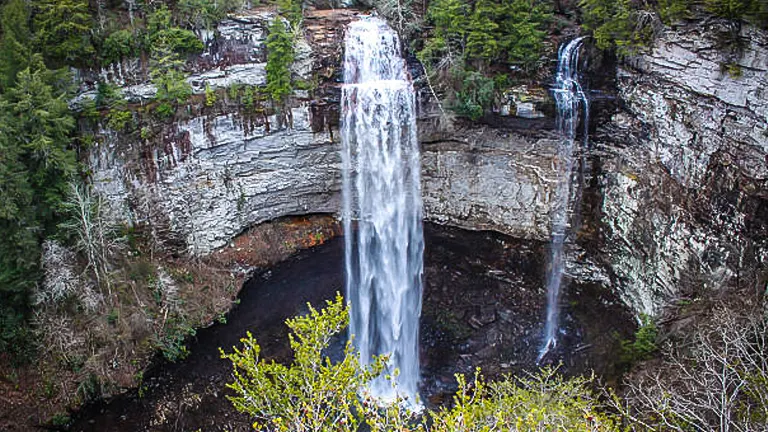
Boasting some of the highest waterfalls in the eastern United States, Fall Creek Falls State Park is a spectacle of nature’s power and beauty. This park offers a variety of landscapes, from cascading waterfalls to dense forests and a sprawling canopy of hardwoods.
- Location: Van Buren and Bledsoe counties, Tennessee
- Best Time to Visit: Spring and fall for the waterfalls at their most spectacular and the foliage in vibrant colors.
- Key Attraction: Fall Creek Falls, at 256 feet, is the park’s namesake and one of the highest waterfall drops in the eastern U.S.
- Ecosystem: The park’s diverse environments support an array of wildlife, including white-tailed deer, raccoons, and various bird species.
Additional Features:
- Outdoor Activities: Over 50 miles of trails for hiking, mountain biking, and horseback riding.
- Overnight Stays: Options range from RV camping sites to cabins and an inn with rooms and suites.
11. Baxter State Park, Maine

A wilderness haven that epitomizes Maine’s natural beauty, Baxter State Park is a spectacular, wild landscape founded on the vision of former Governor Percival Baxter. It’s home to Mount Katahdin, Maine’s highest peak, and the northern terminus of the Appalachian Trail, offering a rugged, unspoiled wilderness experience that’s becoming increasingly rare.
- Location: Piscataquis County, Maine
- Best Time to Visit: Summer and early fall for hiking, with winter offering snowshoeing and cross-country skiing opportunities.
- Key Attraction: Mount Katahdin, not just for its height but for its breathtaking vistas and challenging hikes. The park also serves as a critical habitat for Maine’s wildlife, including moose and black bears.
- Ecosystem: Predominantly boreal forest, Baxter State Park is a mosaic of mountainous terrain, vast forests, and pristine lakes and streams, supporting a diverse range of flora and fauna.
Additional Features:
- Wilderness Camping: Offers numerous backcountry sites for a true wilderness experience.
- Wildlife Viewing: Exceptional opportunities to observe moose, black bear, and the elusive lynx in their natural habitats.
- Hiking Trails: Over 200 miles of trails, including the celebrated Knife Edge Trail to the summit of Katahdin.
12. Devil’s Lake State Park, Wisconsin

Surrounded by 500-foot high bluffs, Devil’s Lake State Park is Wisconsin’s largest state park, offering breathtaking views and a range of recreational activities. The park’s 360-acre lake is a jewel set amidst towering cliffs.
- Location: Baraboo, Wisconsin
- Best Time to Visit: Summer for swimming and boating, fall for spectacular foliage.
- Key Attraction: The hiking trails around the lake offer stunning views and access to unique rock formations.
- Ecosystem: The park’s mixed hardwood and coniferous forest is home to deer, foxes, and a variety of bird species.
Additional Features:
- Water Recreation: Kayaking, canoeing, and fishing in the lake.
- Rock Climbing: Popular with climbers of all skill levels.
13. Oleta River State Park, Florida

As Florida’s largest urban park, Oleta River State Park offers a tranquil escape from the hustle and bustle of Miami. This park is a haven for paddlers, mountain bikers, and those seeking a slice of wilderness in the city’s heart.
- Location: North Miami, Florida
- Best Time to Visit: Year-round, though cooler months from November to April offer the most comfortable climate.
- Key Attraction: The Oleta River, for its mangrove forest kayaking trails.
- Ecosystem: The park’s mangroves and upland areas provide critical habitat for a wide range of species, including manatees and numerous bird species.
Additional Features:
- Mountain Biking: Over 15 miles of trails ranging from novice to challenging.
- Camping and Picnicking: Equipped with cabins and large picnic areas.
Planning Your Visit
When planning your state park adventure, remember to check each park’s official website for the latest information on trails, accommodations, and any permits you might need. Packing essentials like water, snacks, comfortable footwear, and a first-aid kit will ensure a safe and enjoyable experience. Always practice Leave No Trace principles to help preserve these natural treasures for future generations.
Conservation and Respect
Visiting these parks is a privilege that comes with the responsibility to protect and conserve their natural beauty. Adhere to park rules, stay on designated trails, and respect wildlife to ensure these places remain vibrant and intact for years to come.
Conclusion
Exploring the best U.S. state parks is more than a journey through nature—it’s an adventure into the heart of America’s diverse landscapes. From the serene waters of Oleta River State Park to the towering waterfalls of Fall Creek Falls, each park offers a unique window into the natural world. As 2024 approaches, make plans to explore these wonders, and discover the beauty, serenity, and adventure that lie in the great outdoors.
FAQs
- What makes these state parks stand out from national parks?
Unlike national parks, these state parks often have fewer crowds, allowing for a more intimate connection with nature. They also offer unique local biodiversity and geological formations, reflecting the diverse beauty of each state’s natural landscape. - Are there any state parks in this guide suitable for families with young children?
Yes, many parks in the guide, such as Custer State Park and Silver Falls State Park, offer family-friendly amenities, including easy hiking trails, picnic areas, and educational programs designed to engage children with the natural world. - What activities can I expect to find in these state parks?
Beyond hiking and camping, many state parks offer a range of activities such as kayaking, mountain biking, wildlife viewing, and even stargazing in designated Dark Sky Parks. Each park has its unique set of attractions, catering to a wide array of interests. - How were the parks selected for the 2024 guide?
The parks were chosen based on their exceptional natural beauty, diversity of recreational activities, conservation efforts, accessibility, and visitor reviews. This selection process ensures a well-rounded experience for all types of travelers. - Do I need any permits or reservations to visit these parks?
While some parks may require day-use permits or parking reservations, others might need advance booking for camping or special activities. It’s advisable to check the specific park’s website for the most current information before your visit. - Are there any hidden gems in these state parks that aren’t widely known?
Absolutely! Each park has its lesser-known attractions, such as the remote backcountry trails in Porcupine Mountains Wilderness State Park or the underwater caves in Devil’s Lake State Park. These hidden gems offer a unique adventure for those looking to go off the beaten path. - What are the best tips for a sustainable visit to these parks?
Practice Leave No Trace principles, stay on designated trails, use eco-friendly products, and participate in park conservation programs if available. Respecting wildlife and natural resources ensures these parks remain pristine for future visitors. - Can I visit these state parks year-round, or are there seasonal closures?
While many of the parks are open year-round, some may have seasonal closures or limited access during certain months, especially those with harsh winter conditions. Always check the park’s official site for up-to-date information on accessibility and best visitation times.
Explore our dedicated section on national forests and state parks to uncover hidden gems and outdoor wonders. Discover top recommendations in our best section, and delve into in-depth product reviews in our review section.
We’d love to hear about your state park adventures! Share your stories, tips, and favorite moments in the comments below, and let’s inspire a community of explorers and conservationists dedicated to enjoying and preserving these natural wonders.

Benjamin Brooks
Forestry AuthorGreetings! I'm Benjamin Brooks, and my journey over the past 15 years has revolved around the fascinating realms of content creation, expertise in snow clearing, and the intricate world of lumberjacking and landscaping. What began as a simple curiosity about the natural world and heavy machinery has evolved into a passionate profession where my love for crafting words intertwines seamlessly with my lumberjacking and garden skills.













Leave your comment